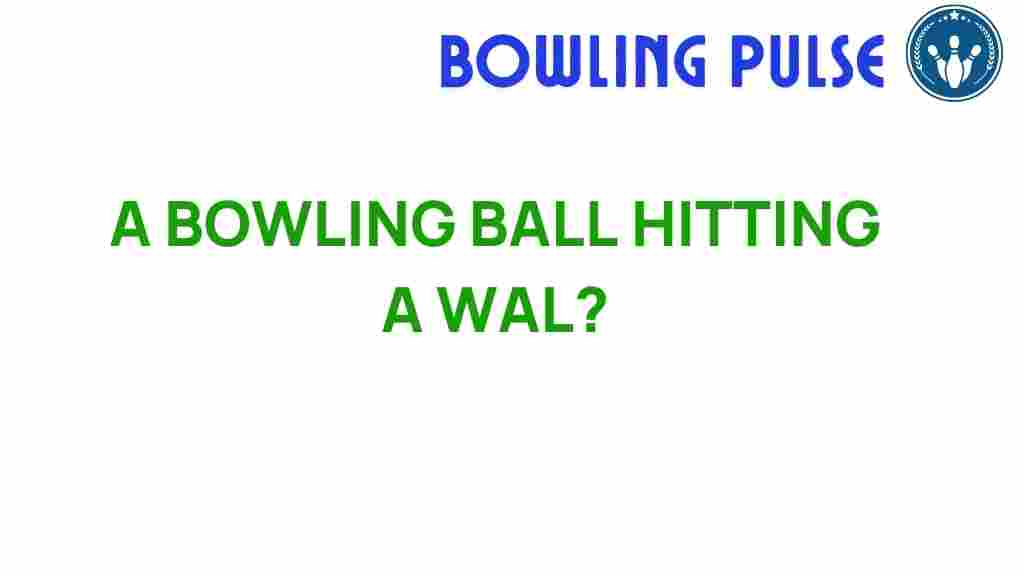The Surprising Physics of a Bowling Ball
When we think of sports, we often consider the skills required to excel in various games. However, behind every athletic feat lies a complex web of physics that governs motion, impact, and energy transfer. One fascinating example is the bowling ball hitting a wall. Understanding the physics of this collision can provide insights not only into sports science but also into engineering principles that apply broadly. In this article, we will explore the dynamics at play when a bowling ball strikes a wall, examining concepts such as momentum, impact forces, and wall dynamics.
Understanding Momentum and Collision
Momentum is defined as the product of mass and velocity. In the case of a bowling ball, the momentum before the collision can be calculated using the formula:
Momentum (p) = Mass (m) × Velocity (v)
As the bowling ball rolls towards the wall, it carries a certain amount of momentum. When it collides with the wall, several outcomes can occur depending on the nature of the collision.
- Elastic Collision: Both momentum and kinetic energy are conserved. The bowling ball bounces back without losing speed.
- Inelastic Collision: Momentum is conserved, but kinetic energy is not. The ball may deform and lose some energy, resulting in a slower rebound.
In bowling, most collisions are inelastic due to the materials involved. The wall absorbs some of the energy, leading to a different outcome than a perfectly elastic collision.
Impact Forces and Energy Transfer
When the bowling ball strikes the wall, it exerts a force on the wall, and the wall exerts an equal and opposite force on the ball, as described by Newton’s third law of motion. The impact force can be calculated using the formula:
Force (F) = Change in Momentum (Δp) / Time (Δt)
Here, the change in momentum is the difference between the momentum before and after the collision, and the time is the duration of the impact. The shorter the time of impact, the larger the force experienced by both the ball and the wall.
Wall Dynamics in Bowling
The wall’s properties significantly influence the collision dynamics. Factors such as the material of the wall, its structure, and its angle can affect the outcome. For instance:
- Material: A concrete wall will have a different reaction compared to a padded wall. The energy absorbed by the materials alters the behavior of the bowling ball post-collision.
- Angle: If the wall is angled rather than perpendicular, the ball may deflect at different angles, changing its trajectory.
Understanding these dynamics is crucial for sports engineers who design bowling alleys and training facilities to enhance player performance while ensuring safety.
Bowling Techniques and Physics
The physics of a bowling ball hitting a wall also informs bowling techniques. Bowlers can adjust their approach based on the energy they want to transfer to the pins. Here are some techniques influenced by physics:
- Speed Control: A faster bowling ball has more momentum, increasing the force during impact with the pins. However, too much speed can lead to loss of control.
- Angle of Release: The angle at which the bowler releases the ball affects its trajectory and the angle of collision with the pins.
- Spin: Adding spin changes the ball’s interaction with the pins and can affect the angle of deflection after impact.
By mastering these techniques, bowlers can optimize their performance based on the principles of physics.
Step-by-Step Process of a Bowling Ball Collision
To illustrate the physics behind a bowling ball hitting a wall, let’s break down the process step-by-step:
- Preparation: The bowler sets up their stance, considering the angle and speed they want to achieve.
- Release: The bowler releases the ball, initiating its motion towards the wall (or pins).
- Impact: The bowling ball collides with the wall, where the impact forces come into play.
- Energy Transfer: Some energy is absorbed by the wall, while some is transferred back to the bowling ball, influencing its rebound.
- Post-Collision Dynamics: The bowling ball may roll back or deflect, depending on the nature of the collision.
Troubleshooting Common Issues
Understanding the physics of bowling can help troubleshoot common issues faced by bowlers. Here are some tips:
- Ball Not Hooking: If your bowling ball doesn’t hook, consider adjusting your release angle or adding more spin.
- Inconsistent Speeds: Practice maintaining a consistent speed at release to ensure predictable momentum.
- Ball Reaction on Impact: Experiment with different ball weights and materials to find what works best for your style.
By applying these troubleshooting tips, bowlers can improve their game through a better understanding of the underlying physics.
Conclusion
The surprising physics of a bowling ball hitting a wall reveals the intricate dynamics of momentum, impact, and energy transfer. Understanding these principles not only enhances one’s appreciation for the sport but also aids in developing better bowling techniques. As sports science continues to evolve, integrating physics with practice can lead to improved performance and safety in bowling.
For more information on sports physics and its applications, check out this external resource on the dynamics of sports equipment. Additionally, if you are interested in improving your bowling skills, consider visiting our bowling techniques guide.
This article is in the category Techniques and created by BowlingPulse Team
